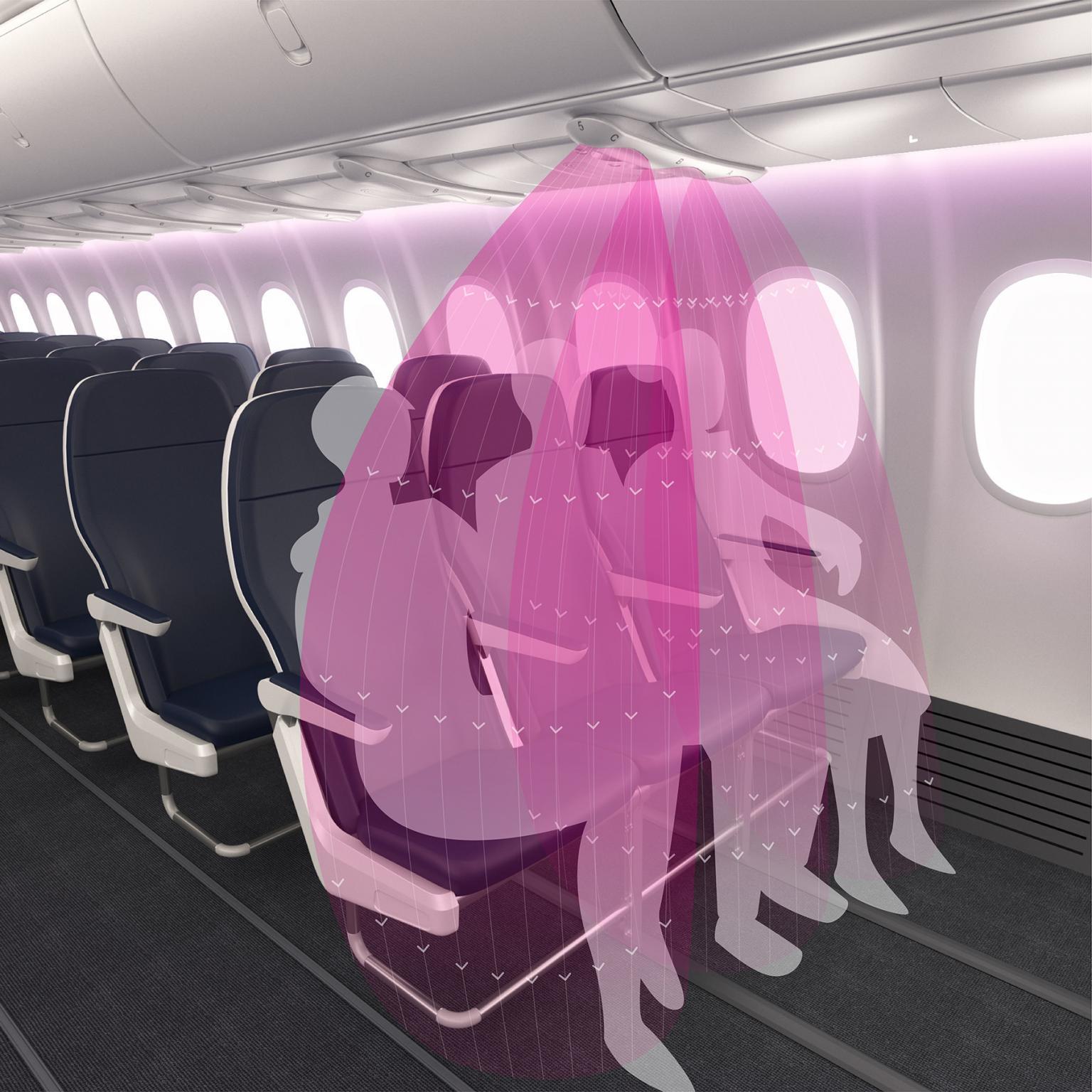
As the aviation industry searches for ways to make passengers feel safer in the COVID-19 environment, one innovation company is looking beyond cabin hygiene and new seat designs with barriers.
Instead of introducing more surfaces to clean in the cabin, Seattle-based Teague is challenging the industry to simply look up—to the personal gasper air vents above each passenger seat, which the company believes have the potential to offer additional protection against virus spread by optimizing the downward flow of air to virtually separate each passenger with a curtain of air.
“Cabin hygiene is not the big problem; it’s not the reason people aren’t flying. It’s because they are scared of a respiratory infection. There’s nothing more unpredictable than the travel of tiny, invisible particulates,” Teague senior director of airline experience Anthony Harcup told ATW.
In mid-June, the company introduced AirShield—a patent-pending germ isolation product that adapts cabin airflow to prevent the spread of viruses by creating a protective air barrier around each passenger.
“There’s a big misunderstanding about how germs travel on an aircraft,” Harcup said. “In an aircraft environment, it is airflow and not the physical distance between passengers that plays the most significant role in the spread of a virus. By engineering the cabin airflow to manage each individual’s exhalations, passengers can have far greater peace of mind.”
But first passengers have to understand cabin air movement. According to Teague, onboard high-efficiency particulate air (HEPA) filters on modern aircraft continuously clean cabin air—removing 99.97% of particles. In addition, federal regulations mandate that the cabin air is continually refreshed with air from outside the plane, ensuring that the air in the cabin is approximately a 50/50 mix of fresh air from outside and recirculated filtered air.
“The result is that the cabin air is entirely refreshed every two to three minutes,” the company stated.
Currently, Harcup said the primary intent of the gasper system is for passenger comfort, not protection, but AirShield aims to improve the effectiveness of gasper airflow to mitigate the spread of contagions.

Credit: Teague
AirShield is a single 3D-printed component that fits directly onto the passenger service unit positioned above every passenger in the cabin. “By utilizing the airflow from the existing overhead air-gaspers, AirShield transforms freshly purified air into engineered ‘air-blades’ capable of controlling the spread of droplets much more effectively,” the company states.
As a result, “When a passenger breathes, coughs or sneezes, the water vapor droplets are contained within that passenger’s space and immediately redirected downward and out of the cabin to the HEPA filtration units, before they have the opportunity to enter the personal space of a neighboring passenger.”
Harcup, who is co-inventor of AirShield, said the final form of the product will be customized to suit specific aircraft and airline cabin designs. “Individual units can be uniquely engineered per aircraft type, class layout or specific seating row. The adaptors are designed to be 3D-printed from aerospace-approved material to allow an optimized shape, rapid production, and flexibility to install onto any aircraft.”
He believes it is simply not commercially viable for airlines to reconfigure entire cabins to adhere to physical distancing measures—especially in economy class where passenger density is at its highest.
“There’s no evidence to suggest that a reconfigured interior would guarantee passengers protection from infectious droplets traveling through the cabin. People can’t choose what air to breathe,” he said.
Unlike new seat and cabin designs, Harcup said airlines can benefit from AirShield because it does not require seat recertification; airlines can fly normal load factors; the whole shipset can be installed overnight by a service bulletin; and it can be fitted within three months of point of contract.
He said the patent-pending AirShield is in the early stages of prototype development and flight testing. In addition, he said the company has a “very interested partner that will enable us to do a flight test within the next four weeks.”
Harcup believes coronavirus and the use of masks will go away long-term; however, the world’s expectations for elevated hygiene post-pandemic will remain.
“The AirShield is a sustainable investment and has post-COVID value,” he said, adding the product could create a “new standard for air cleanliness and will future-proof us for the next pandemic.”





